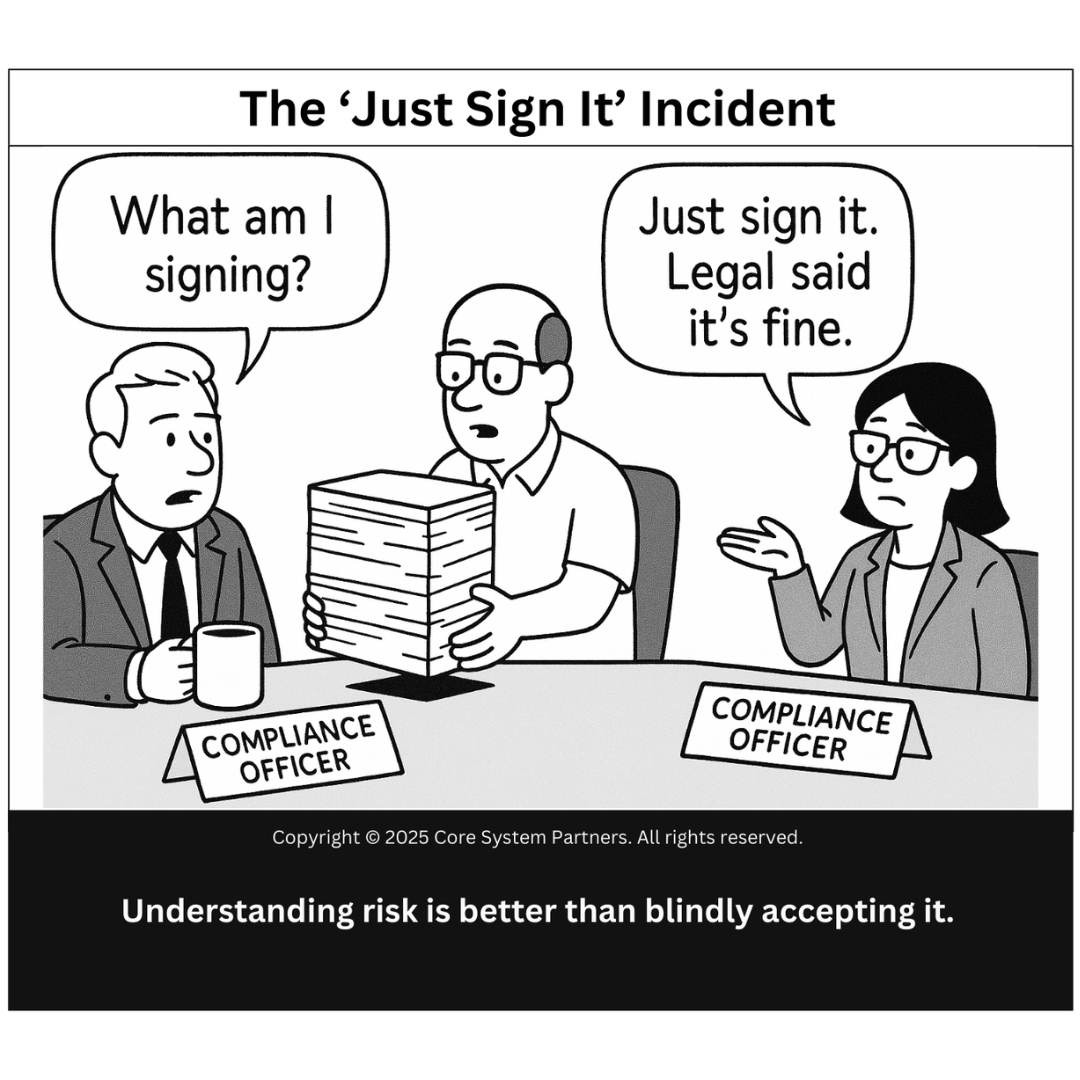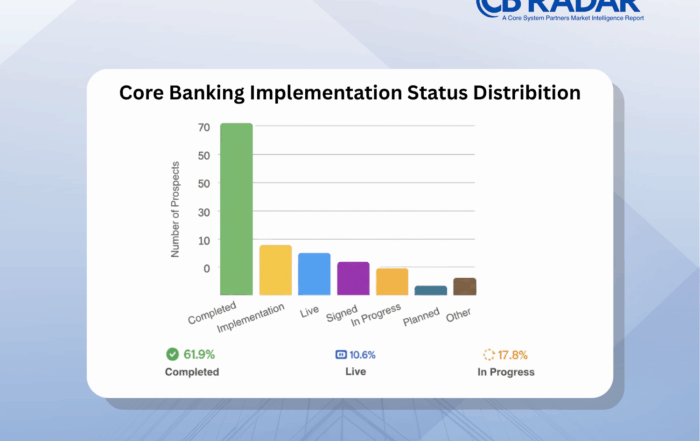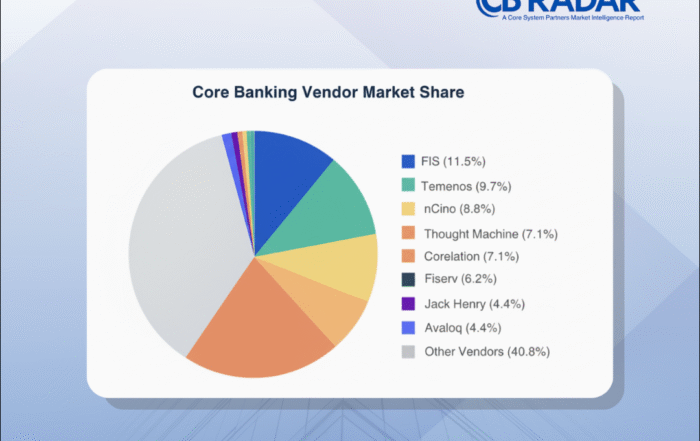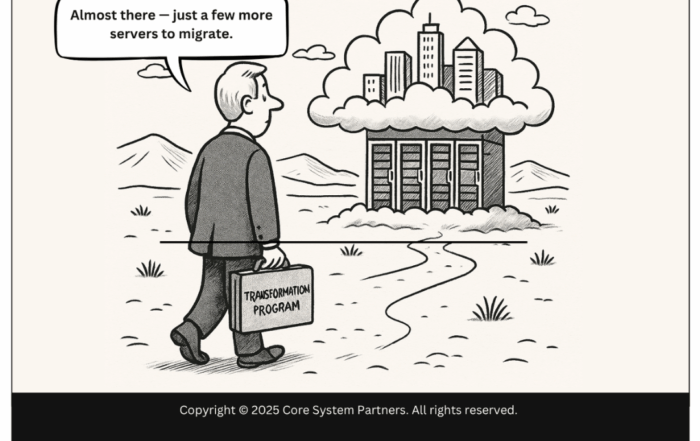
The “Just Sign It” Incident – Understanding risk is better than blindly accepting it.
“What am I signing?”
“Just sign it. Legal said it’s fine.”
If this sounds familiar, you’re not alone. We’ve all sat in that meeting—pen in hand, stack of documents in front of us, and a vague assurance from someone down the hall that “it’s been reviewed.” But here’s the thing: safety by delegation is not the same as understanding risk.
In banking—especially when core systems are on the table—signing off blindly can be more dangerous than not signing at all.
Rubber-Stamped Risk: A Cultural Red Flag
In theory, banks are risk-aware. We have policies. We have compliance officers. We have legal reviews. But in practice?
We sometimes treat risk signoffs like seatbelt clicks—rituals, not reassurances.
The problem? Risk gets buried in legalese. Responsibility gets passed like a hot potato. And decisions get made with more confidence than clarity.
That’s how banks sign off on:
- Core system contracts with hidden lock-ins.
- Vendor agreements with impossible SLAs.
- Transformation timelines that ignore integration realities.
And then wonder why six months in, they’re in a mess they didn’t see coming.
A Personal Example: The Clause We Didn’t Question
We worked with a mid-size bank that outsourced part of their mobile banking stack. On paper, the vendor contract looked standard. Legal signed off. IT signed off. The exec signed off. All smooth.
Six months later, they discovered the vendor owned all transactional usage data.
Not access to it. Ownership.
They had signed away customer behavior insights—the very data they needed for personalization, fraud monitoring, and AI modeling. But no one had really understood the implication. Everyone assumed someone else had read that section.
They didn’t lose data. But they lost leverage.
The Real Risk? Assuming Someone Else Is Managing It
In transformation programs, risk isn’t always obvious:
- It hides in integration assumptions.
- It lurks in licensing fine print.
- It emerges from incomplete process handoffs.
And too often, someone signs off without fully grasping what’s inside.
Ask yourself:
- Are signoffs being done with genuine understanding—or out of process fatigue?
- Does your team know the difference between legal risk and operational risk?
- Do your project leaders have a clear, shared language around risk categories?
If not, you’ve got a gap. And gaps in transformation risk don’t stay hidden for long.
From Rubber Stamps to Real Risk Governance
Here’s what high-performing banks do differently:
1. Make Risk Explicit
Instead of a signoff checklist, build a risk canvas:
- What’s the likelihood?
- What’s the impact?
- Who’s the risk owner?
- What are the mitigation paths?
And don’t do this just once. Revisit it quarterly. Risk changes with progress.
2. Differentiate Legal Approval from Business Understanding
Legal reviews are necessary—but they’re not sufficient. A clause may be legally sound and strategically unwise.
Train your leadership teams to:
- Read contracts with a business lens.
- Ask “what’s the operational consequence?” not just “is it enforceable?”
- Bring in product, tech, and ops for contextual input before signing.
3. Slow Down Just Enough
It’s tempting to race through procurement. Everyone’s chasing milestones. But transformational decisions deserve better than “Just sign it.”
If you don’t have time to understand the risk, you don’t have time to accept it.
The Risk of Not Understanding Risk
In core banking transformations, risk shows up in surprising places:
- Contractual constraints that outlive the platform they govern.
- Migration responsibilities that vendors say are “shared” but never defined.
- Performance guarantees that only trigger after significant financial loss.
The worst time to discover these? When the system is already live.
Good Risk Governance Is a Muscle, Not a Document
One executive once told us, “We don’t need more signatures. We need more conversations before we sign.”
Exactly.
Risk literacy shouldn’t be limited to the compliance team. It should be part of your:
- Transformation playbooks
- Procurement processes
- Quarterly board updates
And yes, your culture.
Let’s Make Risk Smarter, Not Just Safer
Understanding risk doesn’t mean fearing it. It means contextualizing it. We’re not saying every contract needs to be litigated internally. But every critical signoff should come with:
- A one-paragraph risk summary
- Clear accountability
- A traceable rationale
If you can’t explain the risk to a non-expert in 90 seconds, you don’t understand it well enough to sign.
Want to Turn Risk Signoffs Into Strategic Strength?
The OptimizeCore® Scorecard helps banks identify transformation risks before they become transformation regrets. We look at vendor terms, operating model changes, migration pitfalls, and more.
Don’t wait until someone asks, “Why did we agree to this?”
Because in banking, what you don’t know can hurt you. And what you blindly sign off on? Even more so.
#CoreBankingTransformation #CoreBankingOptimization





